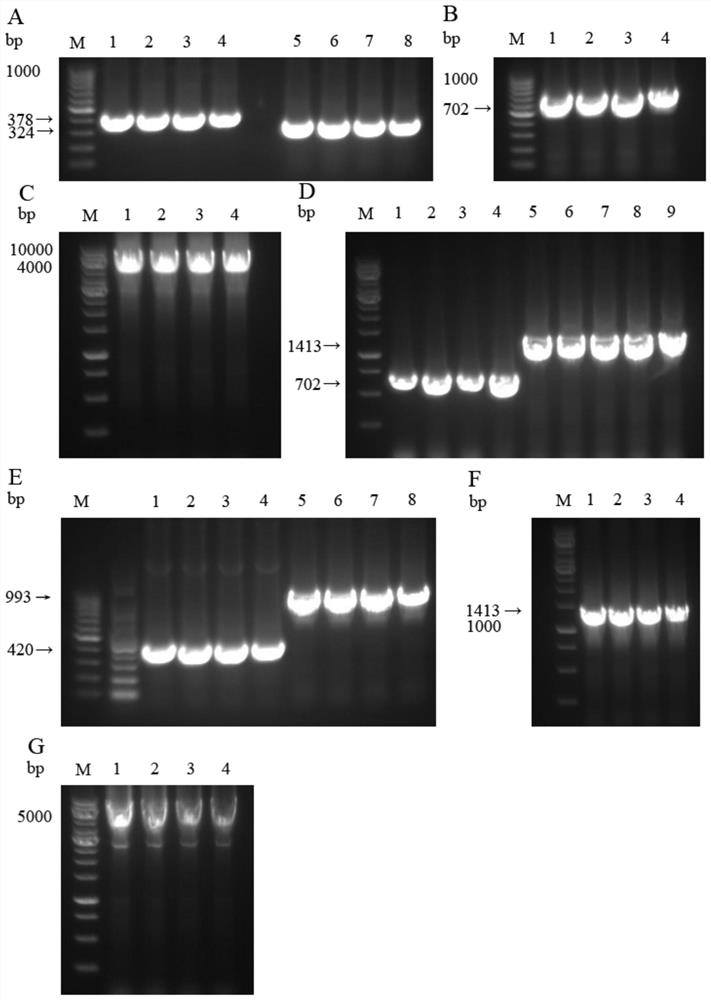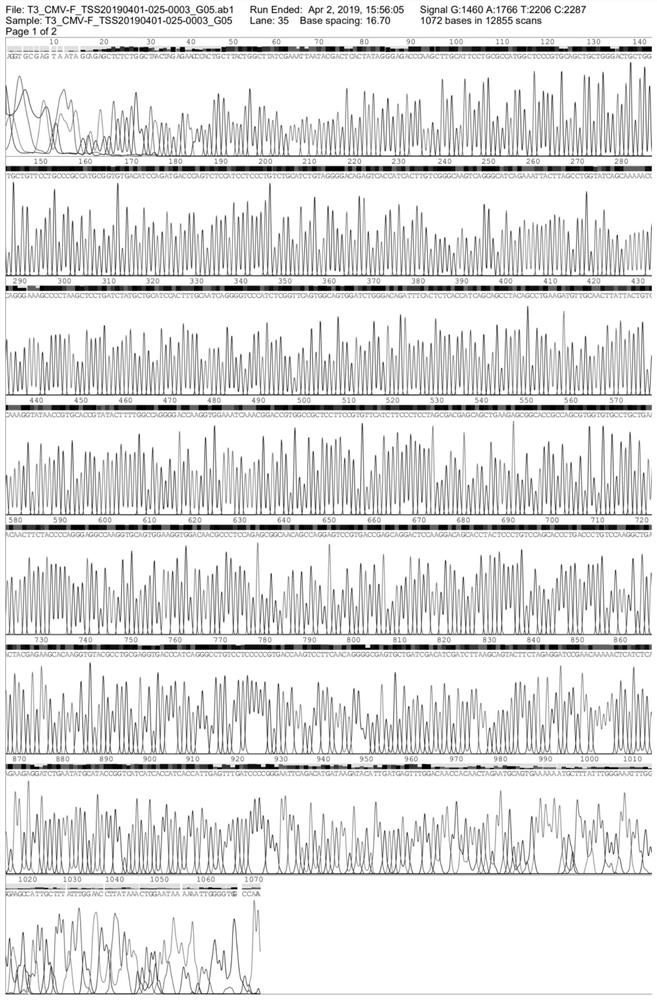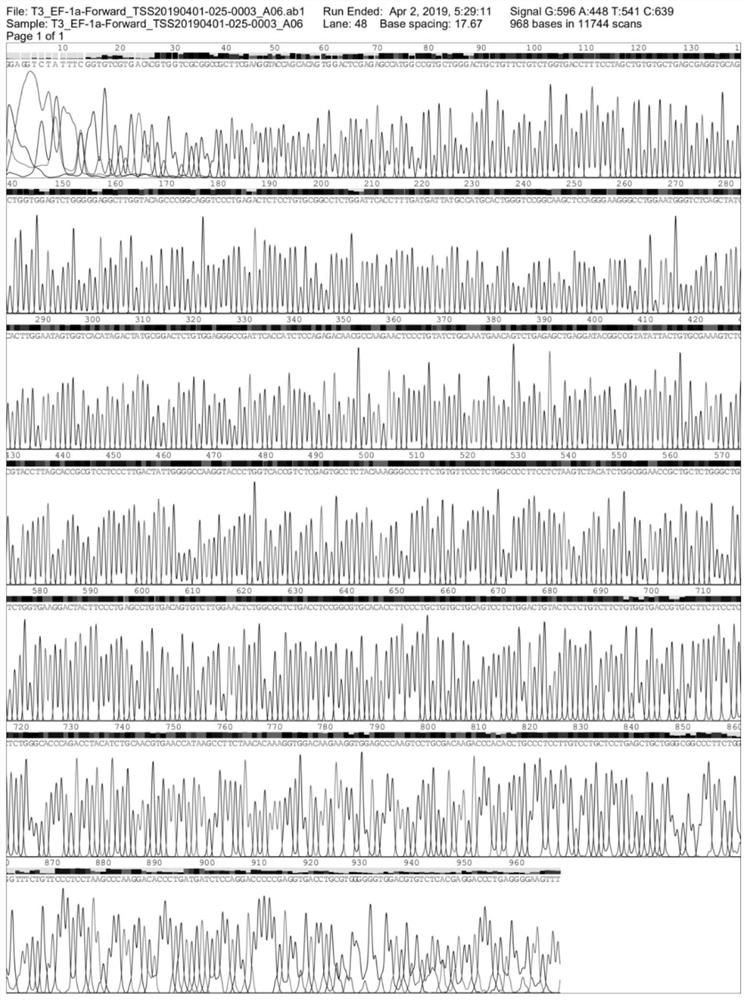Anti-tnf-α/pd-1 bispecific antibody and its application
A bispecific antibody, PD-1 technology, applied in the direction of antibodies, applications, specific peptides, etc., can solve the problems of low tissue penetration rate, long half-life, etc., and achieve the effect of good antigen binding activity
- Summary
- Abstract
- Description
- Claims
- Application Information
AI Technical Summary
Problems solved by technology
Method used
Image
Examples
Embodiment 1
[0074] Example 1: Anti-TNF-α plasmid construction of bispecific antibody
[0075] (1) Anti-TNF-αVL region gene and Anti-TNF-αKappa region gene amplification and connection
[0076] Use P1, P2 to amplify Anti-TNF-α VL region gene, use P3, P4 to amplify Anti-TNF-α Kappa region gene, P1, P2, P3, P4 primer sequences are as follows:
[0077] P1: 5'-GACCCAAGCTTGCATTCCTGCGCCATGGCTCCCGTGCAGCT-3' (SEQ ID NO: 17)
[0078] P2: 5'-GAGCGGCCACGGTCCGTTTGATTTCCACCTTGGTCCC-3' (SEQ ID NO: 18)
[0079] P3: 5'-ACCAAGG TGGAAATCAA ACGGACCGTGGCCGCTC-3' (SEQ ID NO: 19)
[0080] P4: 5'-AAGTACTGCTTAAGATCGATGTCGATCAGCACTCGCCCCTGTT-3' (SEQ ID NO: 20)
[0081] 1) Anti-TNF-α VL region gene amplification. The reaction system is shown in Table 1; the amplification reaction conditions are shown in Table 2.
[0082] Table 1 Anti-TNF-α VL region gene amplification reaction system
[0083]
[0084] Table 2 Anti-TNF-α VL region gene amplification reaction conditions
[0085]
[0086] 2) Anti-TNF-α Ka...
Embodiment 2
[0155] Example 2: Anti-PD-1 plasmid construction of bispecific antibody
[0156] (1) Anti-PD-1 light chain vector construction
[0157]Use P13 and P14 to amplify the Anti-PD-1 light chain gene, and use P5 and P6 to amplify the pBudCE 4.1 vector fragment. The primer sequences of P13 and P14 are as follows:
[0158] P13: 5'-GACCCAAGCTTGCATTCCTGCGCCACCATGGCTCCCGTG-3' (SEQ ID NO: 29)
[0159] P14: 5'-AAGTACTGCTTAAGATCGATGTCGACTCGAGTCAGCAGGACTTGGGC-3' (SEQ ID NO: 30)
[0160] 1) Anti-PD-1 light chain gene amplification. The reaction system is shown in Table 15; the amplification reaction conditions are shown in Table 2.
[0161] Table 15 Anti-TNF-α VL region gene amplification reaction system
[0162]
[0163] 2) PCR amplification of the pBudCE 4.1 vector fragment. The reaction system is shown in Table 5; the amplification reaction conditions are shown in Table 6.
[0164] The amplified products were subjected to agarose gel electrophoresis and gel recovery, the results we...
Embodiment 3
[0199] Example 3: Expression and purification of bispecific antibodies
[0200] (1) Suspension cell culture
[0201] Resuscitate 293F suspension cells at 37°C, 8% CO 2 The shaker was cultured at a speed of 120rpm, and OPM-293 CD05 Medium was used to culture for five generations until the cell state was stable. After the cell survival rate was greater than 90% by trypan blue staining, the cells were cultured at 1×10 6 Subculture at a cell / ml density, after 12-16 hours of subculture, wait until the cell density reaches 1.5×10 6 Transfection was performed at 1 cell / ml.
[0202] (2) Cell transfection
[0203] The amount of Anti-PD-1 plasmid and Anti-TNF-α plasmid was 2 μg / ml, and the amount of PEI transfection reagent was 5 μg / ml. The amount of plasmid and transfection reagent was calculated according to the volume of suspended cells. Add Anti-PD-1 plasmid and Anti-TNF-α plasmid to 5ml OPM-293 CD05 Medium, mix gently, and let stand for 20min. Add PEI transfection reagent to 5...
PUM
| Property | Measurement | Unit |
|---|---|---|
| diameter | aaaaa | aaaaa |
Abstract
Description
Claims
Application Information
 Login to View More
Login to View More - R&D
- Intellectual Property
- Life Sciences
- Materials
- Tech Scout
- Unparalleled Data Quality
- Higher Quality Content
- 60% Fewer Hallucinations
Browse by: Latest US Patents, China's latest patents, Technical Efficacy Thesaurus, Application Domain, Technology Topic, Popular Technical Reports.
© 2025 PatSnap. All rights reserved.Legal|Privacy policy|Modern Slavery Act Transparency Statement|Sitemap|About US| Contact US: help@patsnap.com



